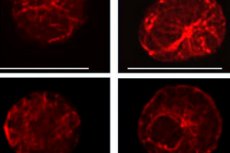New publications
The first stage of allergic reactions has been discovered, opening new avenues for prevention
Last reviewed: 02.07.2025

All iLive content is medically reviewed or fact checked to ensure as much factual accuracy as possible.
We have strict sourcing guidelines and only link to reputable media sites, academic research institutions and, whenever possible, medically peer reviewed studies. Note that the numbers in parentheses ([1], [2], etc.) are clickable links to these studies.
If you feel that any of our content is inaccurate, out-of-date, or otherwise questionable, please select it and press Ctrl + Enter.

Scientists at Duke-NUS Medical School have identified how a chain of events begins after a person comes into contact with an allergen such as peanuts, seafood, pollen or dust mites. Their discovery, published in the journal Nature Immunology, could lead to the development of drugs to prevent severe allergic reactions.
Mast cells, a type of immune cell, are known to mistake a harmless substance such as peanuts or dust mites for a threat and release a first wave of bioactive chemicals against this perceived threat. When mast cells, which reside under the skin, around blood vessels, and in the linings of the respiratory and gastrointestinal tracts, simultaneously release their pre-stored bioactives into the blood, immediate and systemic shock can occur that can be fatal without rapid intervention.
According to the World Health Organization (WHO), more than 10% of the world's population suffers from food allergies. As the number of allergies increases, so does the incidence of food-induced anaphylaxis and asthma. In Singapore, asthma affects one in five children, and food allergies are already the leading cause of anaphylactic shock.
The Duke-NUS team discovered that the release of mast cell granules containing bioactive chemicals is controlled by two components of an intracellular multi-protein complex called the inflammasome. Until now, these inflammasome proteins were only known to spontaneously assemble in immune cells to secrete soluble chemicals that alert other parts of the immune system when infection is detected.
Professor Soman Abraham, Emeritus Professor of Pathology at Duke University, who led the study while working in the Duke-NUS Emerging Infectious Diseases Programme, said: "We found that components of the inflammasome played a surprisingly important role in transporting mast cell granules, which are normally packed in the centre of the cell, to the cell surface where they are released. This unexpected discovery gives us a precise target for intervention to prevent the chain of events initiated by mast cells leading to anaphylactic shock."
Professor Abraham and his team looked at mice that lacked one of two inflammasome proteins, NLRP3 or ASC. When these animals were exposed to allergens, they did not go into anaphylactic shock.
However, anaphylactic shock was observed when NLRP3 and ASC proteins in mast cells assembled and bound to individual intracellular granules, forming a complex the researchers called a granulosome, which promoted the movement of granules along tracks formed by the cytoskeleton inside the mast cell, much like they "attach themselves to train tracks."
Dr Pradeep Bist, first co-author of the paper and principal investigator in the Duke-NUS Emerging Infectious Diseases Programme, said: "When mast cells were activated, we observed rapid movement of granules along dynamic pathways known as microtubules to the cell membrane, where these granules were immediately released from the cell. However, in mast cells lacking NLRP3 or ASC proteins, we found no evidence of intracellular movement of granules and none of these granules were released."
After demonstrating the role of NLRP3 and ASC in granule transport, the team turned to known inflammasome inhibitors to see if they could prevent this event.
Using an inflammasome-blocking drug very similar to those in clinical trials for chronic inflammatory diseases, called CY-09, they administered the therapy to mice before they were exposed to the allergen. They found that in their preclinical model, they were able to effectively prevent anaphylactic shock with the drug.
Dr Andrea Mencarelli, from the Institute of Immunotherapy at Shanghai Jiao Tong University School of Medicine, who was the first co-author of the paper while working in the Duke-NUS Emerging Infectious Diseases Programme, said: "Remarkably, by using a drug that specifically blocked the activity of inflammasome proteins, we were able to selectively block the release of pre-stored mast cell chemicals without affecting other potentially beneficial mast cell functions."
While this is not a cure, it could offer people with severe allergies a new tool to prevent a potentially dangerous reaction from occurring. Currently, emergency treatments are taken immediately after the first symptoms appear. These treatments must be applied within a narrow time window to be effective, and they also have serious side effects.
"I can see how this could provide reassurance to parents of children with severe food allergies when they are faced with situations where it is impossible to be sure there is no risk of exposure. While we don't want to deactivate this part of the immune system for long periods, it could potentially provide short-term protection," said Professor Abraham, whose team is now working to optimise the dosage and frequency of use of the drug to achieve the best protective effects against anaphylactic shock.
"After that, we hope to do the same for asthma and allergic skin reactions."
Professor Patrick Tan, Senior Associate Dean for Research at Duke-NUS, said: "This breakthrough has enormous translational potential and represents a paradigm shift not only for further research but also for improving the quality of life of those at risk of severe allergic reactions. It is a ray of hope, especially for parents of young children who live with constant anxiety."
